Folio Archives 323: The Canterbury Tales by Geoffrey Chaucer 1990
ConversazioniFolio Society Devotees
Iscriviti a LibraryThing per pubblicare un messaggio.
1wcarter
The Canterbury Tales by Geoffrey Chaucer 1990
The Canterbury Tales were written in Old English towards the end of Chaucer’s life between 1390 and his death in 1400. They were left uncompleted. Chaucer was a wealthy man, well travelled, a diplomat and moved in court circles.
The tales themselves are often gruesome (a seven year old boy has his throat cut, a 14 year old girl is beheaded by her father to protect her honour) and bawdy (monks seem to fornicate in many stories), thus making them popular through the ages.
They are difficult to read in the Old English of over 600 years ago, but the edition reviewed here has the original Old English and a modern English translation side by side on opposite pages, making it perfect for both scholar and contemporary reader. The translation is in verse, rather than prose, in an attempt to match the original style as closely as possible. There are introductions by both the translator (David Wright) and editor (E.N.Robinson). Interestingly, the two appendices (the Tale of Melibee and The Parson’s Tale) are not translated.
The 1990 edition reviewed below is in three volumes, but except for its binding is identical to the 1986 edition, and there is no mention in the book that this is actually a new binding from 1990. I find this to be the most pleasing of the many standard editions in both contents and binding. The fine and limited editions are all beautiful, but in Old English.
Each volume is quarter bound in dark brown leather with different colour cloth boards for each volume. The red slipcase is 4.9x15.3cm. The title page and contents of the entire set are repeated at the beginning of each volume.
Volume one : 5 engravings, 332 pages, green boards.
Volume two : 7 engravings, 384 pages, red boards.
Volume three : 12 engravings, 600 pages, dark blue boards.
There are engravings by a multitude of different artists at the beginning of each tale. At the end of the third volume is an extensive glossary and reference to notes throughout the text. The endpapers are an image printed black on grey paper that runs on from the front to the back and is the same in each volume.
The Folio Society has printed the Canterbury Tales numerous times as a standard edition, fine edition and limited edition.
1956
Canterbury Tales, Volume I. Translated by Nevill Coghill. 12 full page and 20 smaller woodcuts by Edna Whyte. Quarter bound in dark brown leather with grey-brown canvas boards. White dust-jacket printed in dark green and black. Design printed endleaves. 287pp. 22x13cm.

1957
Canterbury Tales, Volume II. Translated by Nevill Coghill. Ten full-page and 22 smaller woodcuts by Edna Whyte. Quarter bound in dark brown leather, grey-brown canvas boards. Endleaves with a design in black by Whyte. White dust-jacket printed in dark green and black. 22x12.9cm. 304pp.

1966
Canterbury Tales 2nd. edition, reset. (2v.). Translated into modern English by Nevill Coghill. 22 full page and 42 small woodcut illustrations. Decorated endpapers. Quarter-bound in dark brown leather with canvas boards. Grey-green slipcase. Vol.1 287pp. Vol.2 304pp. Each 22.2x12.5cm.

1974
Canterbury Tales 2nd. edition, as 1966 edition but bound in one volume. Yellow endleaves printed with a brown pattern. Pale brown slipcase. 587pp.

1986
Canterbury Tales. New edition. (3v.). Original text edited by F.N. Robinson. Translation by David Wright. Various illustrators. Quarter bound in red leather, blue cloth boards with a large fleuron in gold. Pale blue endleaves printed in black. Blue slipcase. 23.9x14.3cm. 332/384/600pp.

1990
The edition reviewed below.
1998
Canterbury Tales. Second edition. Single volume version of 1986 edition. Translation, introduction and notes by David Wright. 23 wood engravings by Simon Brett, Peter Forster, John Lawrence, Frank Martin, Peter Reddick, Sue Scullard, George Tute and Sarah van Niekerk. Quarter-bound in red linen with vegetable parchment boards with a gilt design. Red slipcase. 519pp. 24x14.3cm.

2002
Kelmscott Chaucer. Facsimile of 1896 edition by Kelmscott Press. Contains Canterbury Tales and other works by Chaucer. Gilded top edge. Ribbon marker. Bound in white leather blocked in gold with a design by William Morris. Slipcase blocked in gold with title. 568pp. 43.5x31.5cm. Limited edition of 1000 copies.

2008
Kelmscott Chaucer. Facsimile of 1896 edition by Kelmscott Press. Contains Canterbury Tales and other works by Chaucer. Gilded top edge. Ribbon marker. Bound in maroon buckram blocked in gold with a design by William Morris. Brown slipcase blocked in gold with title. 568pp. 43.5x31.5cm. Fine edition.
This edition reviewed here.

2010
Canterbury Tales (2v.). Facsimile printed on felt-marked laid paper, endpapers of Merida Graphite, bound in Nigerian goatskin leather blocked with a 24-carat gold design, gilding on all three book edges, black satin ribbon marker, 768pp. Commentary essay by Peter Holliday quarter-bound in buckram. Buckram-bound solander box with gold blocking on the spine. 12½x7¾in. Limited edition of 1980 copies.

The Canterbury Tales by Geoffrey Chaucer in three volumes - 1990


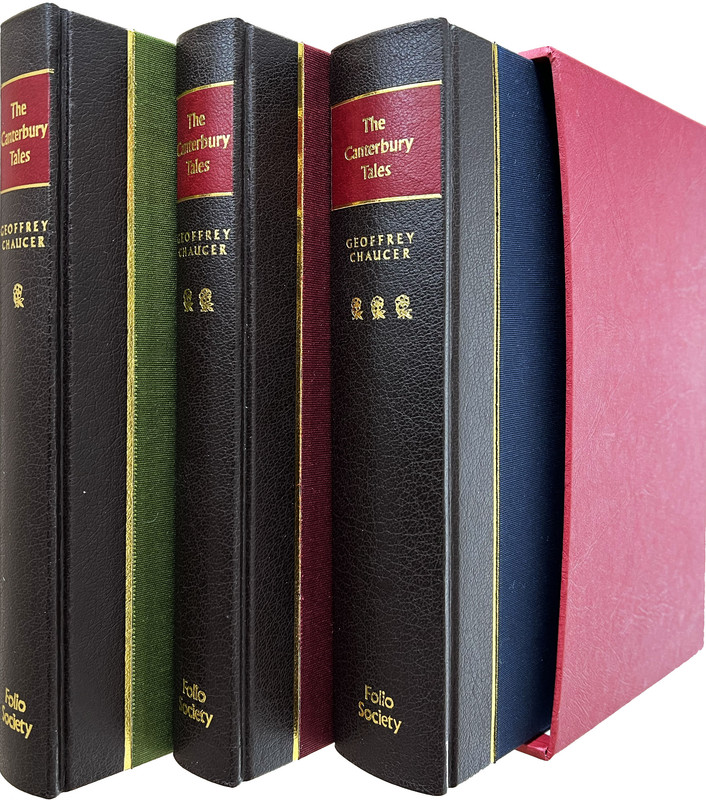
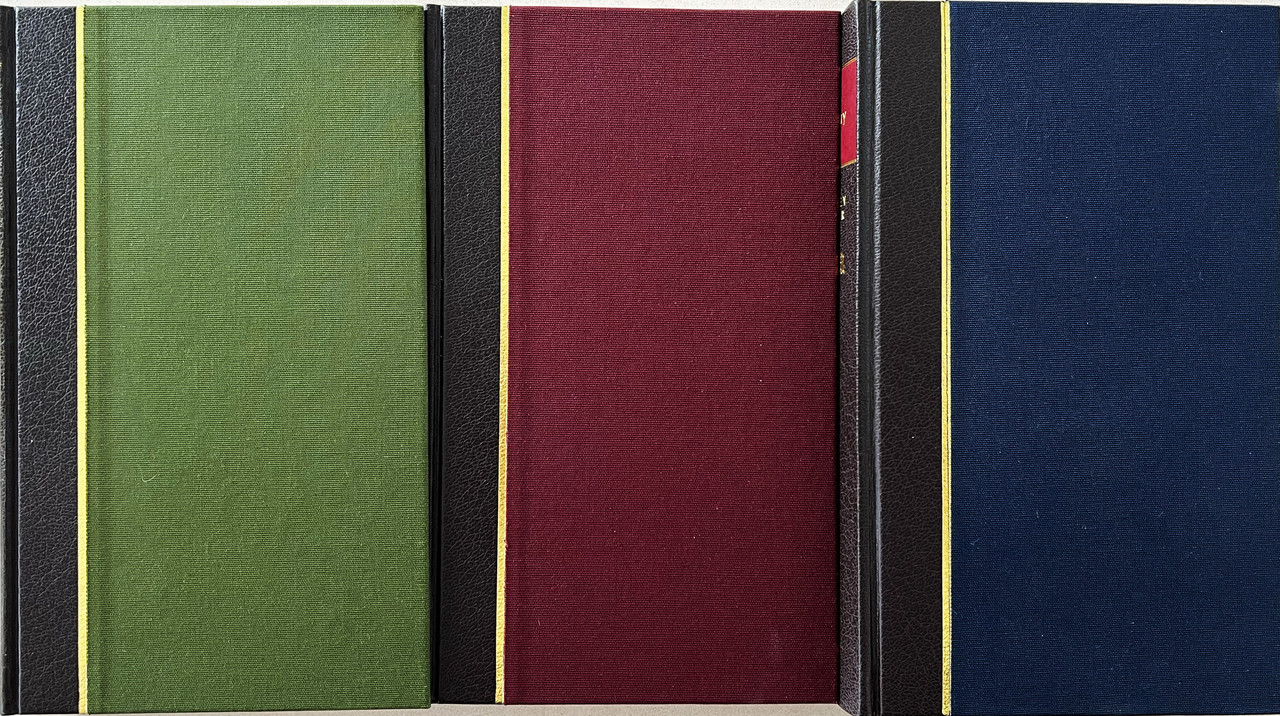
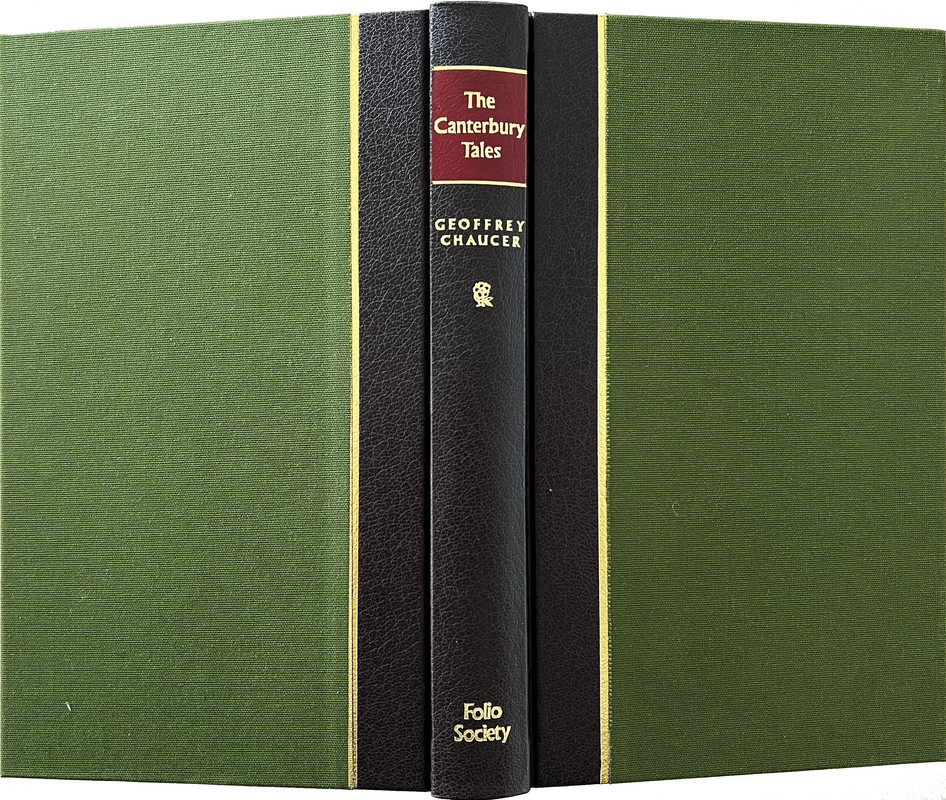
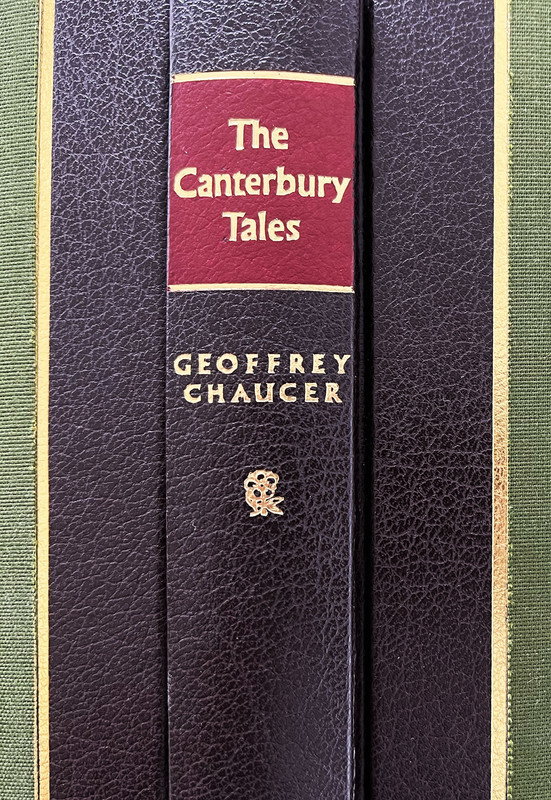
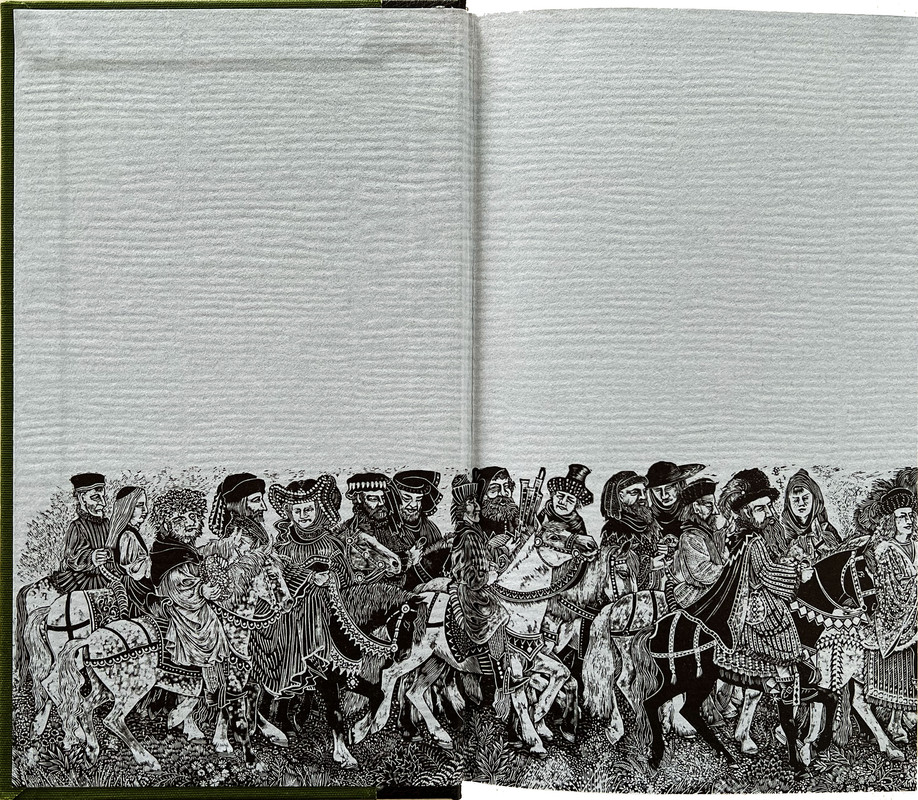
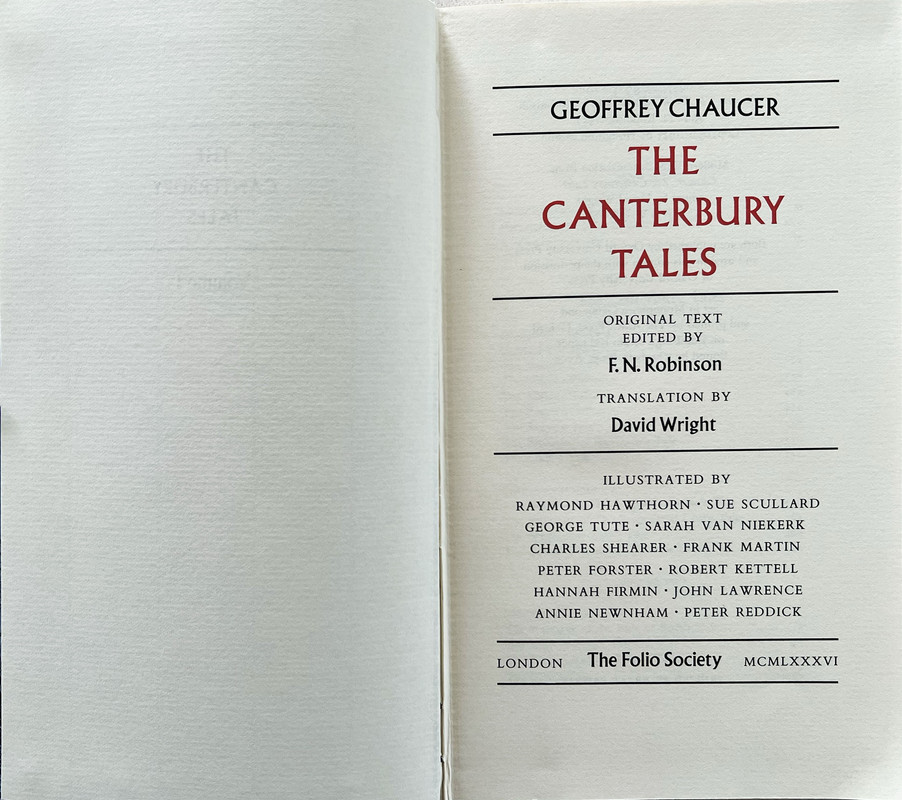


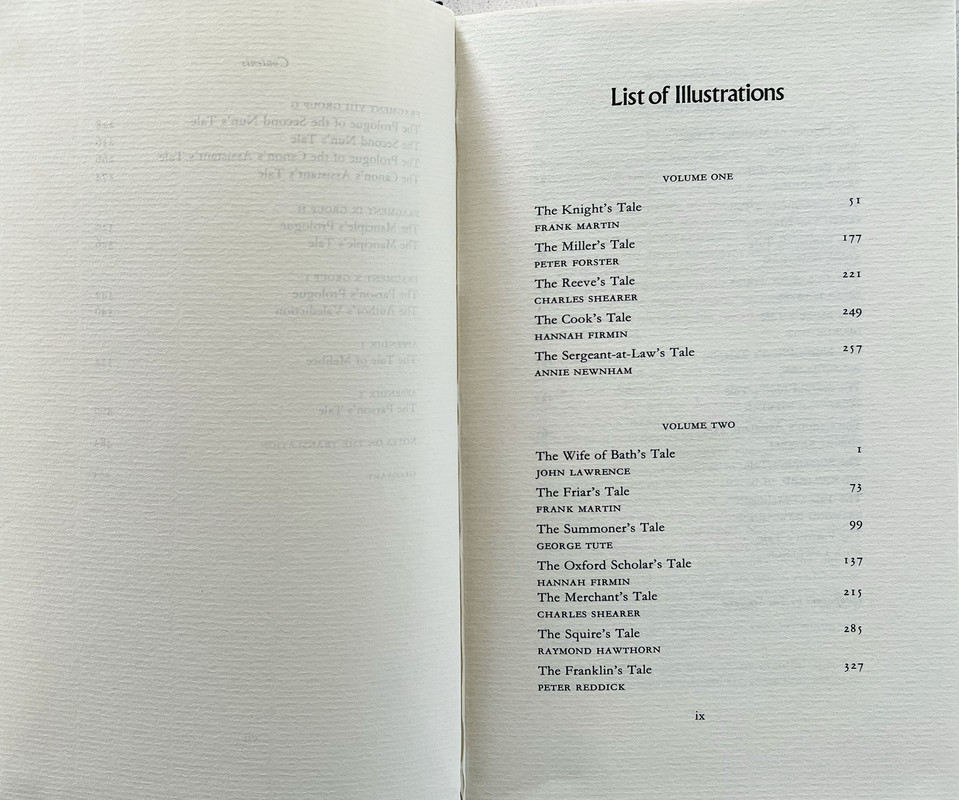
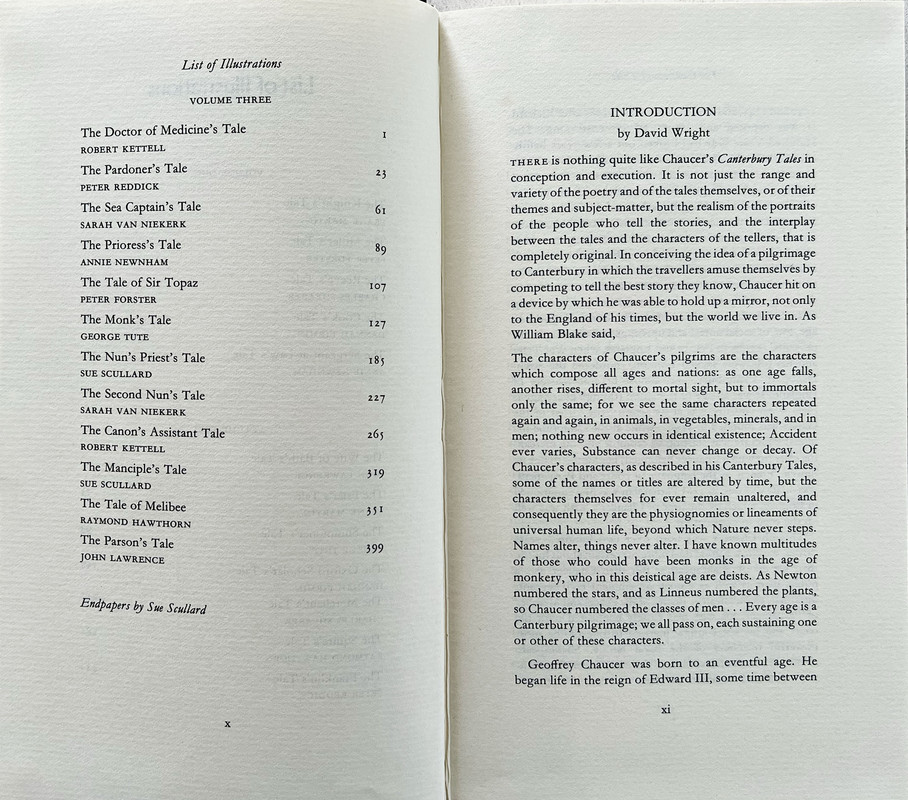
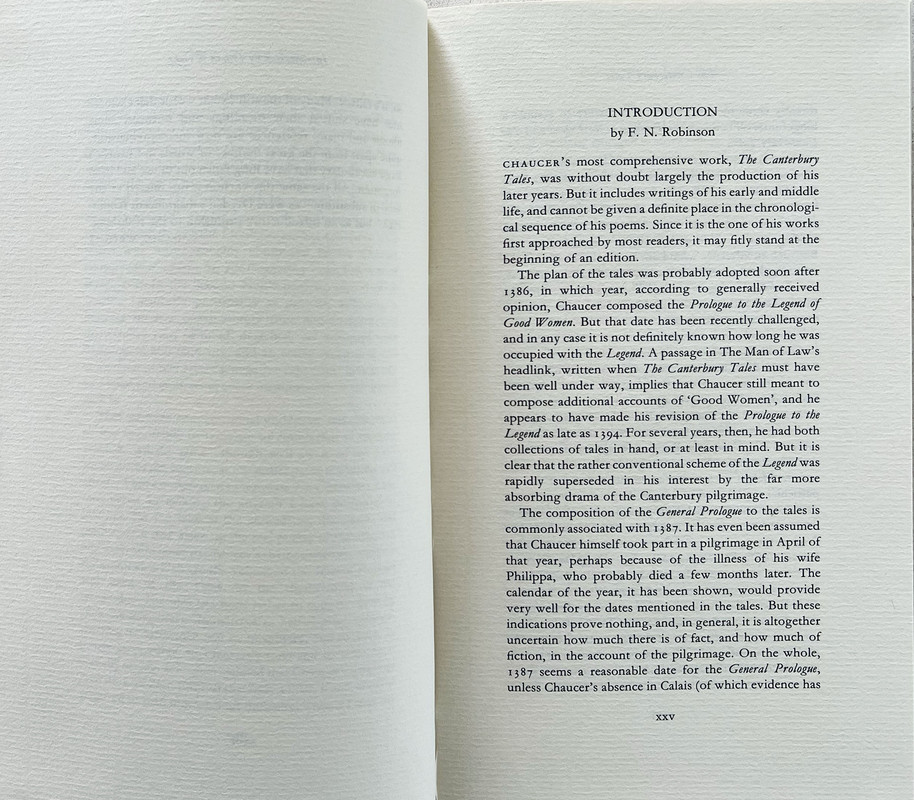
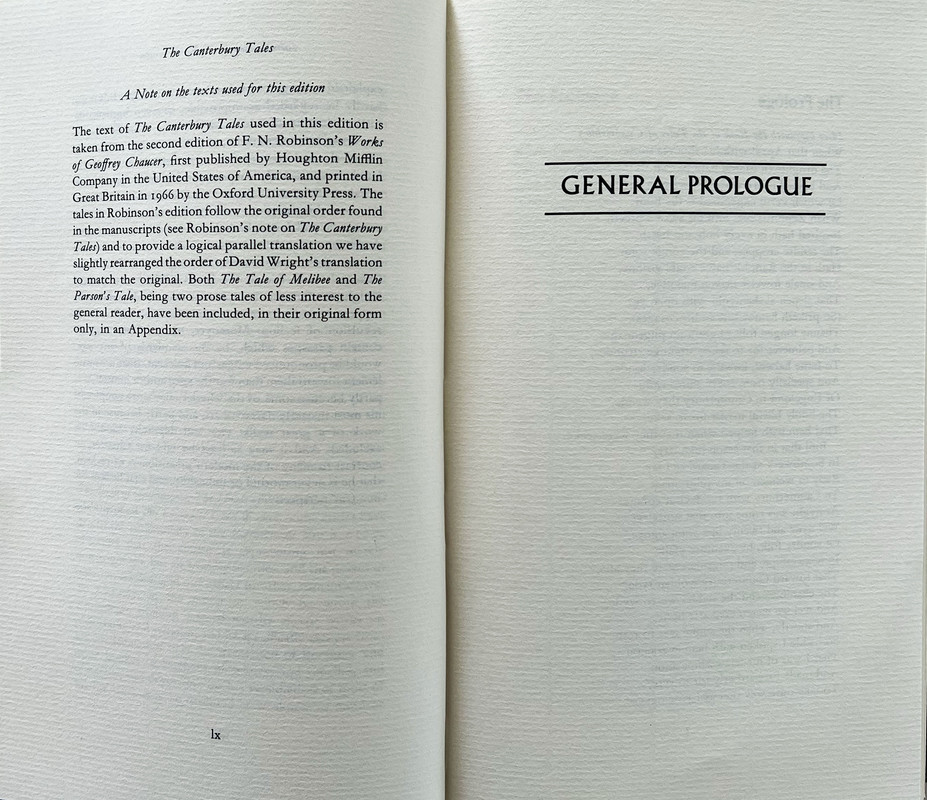
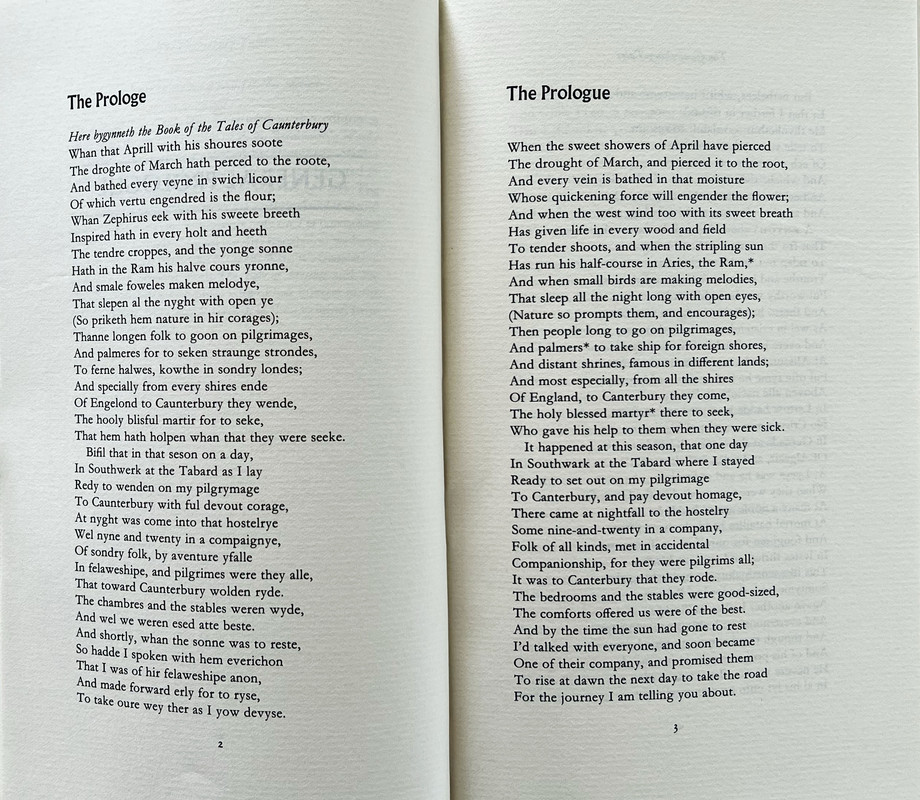
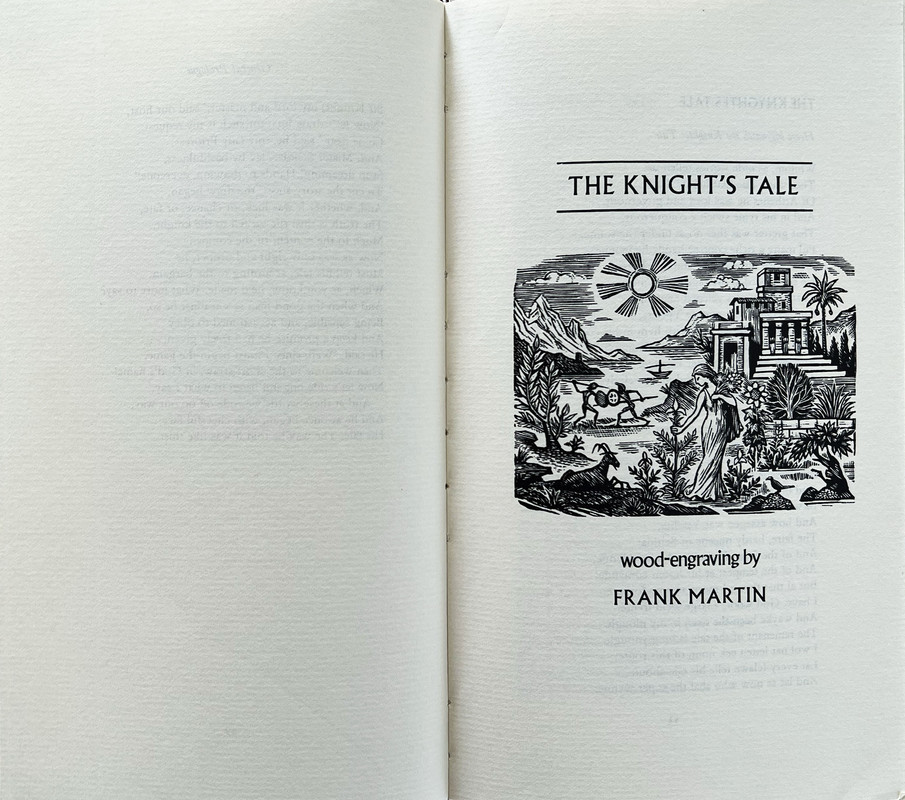

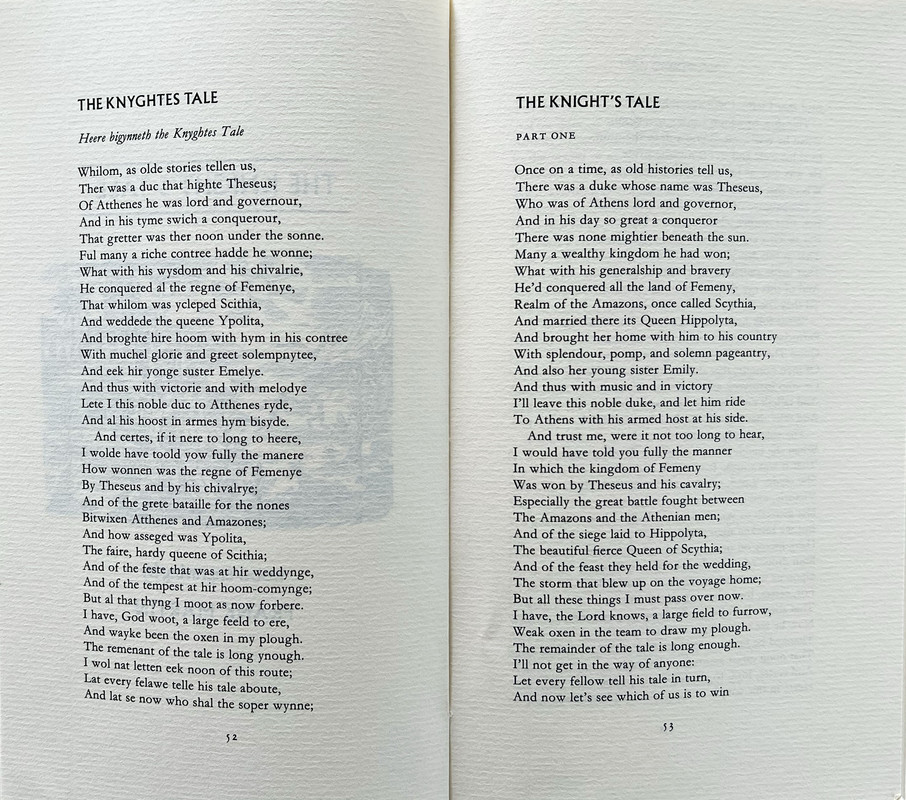


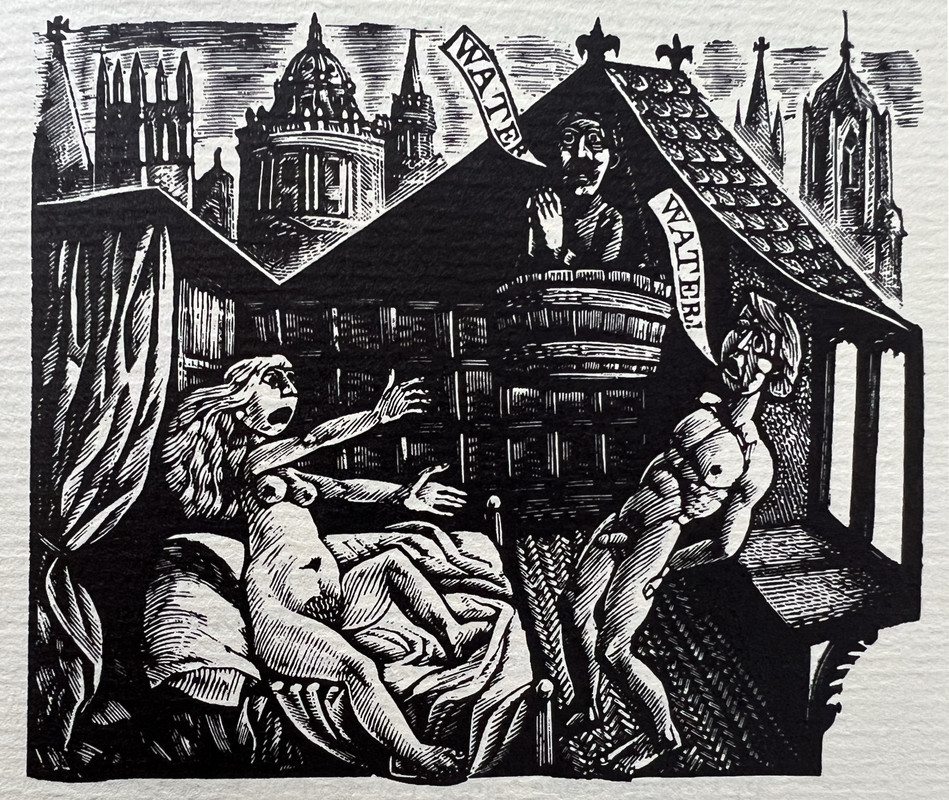
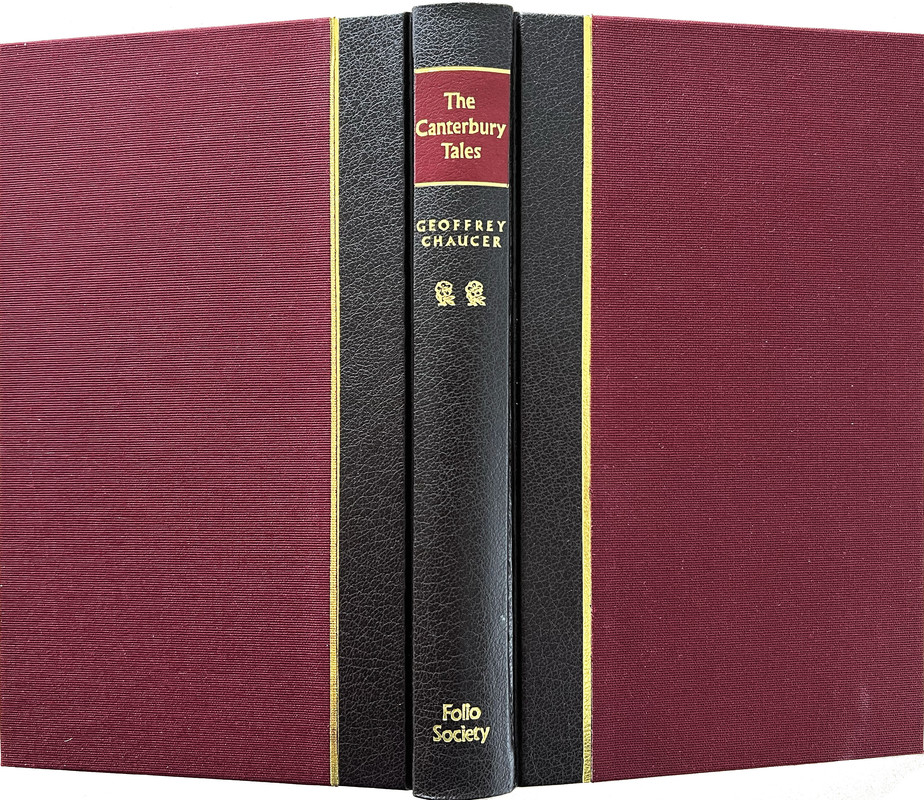
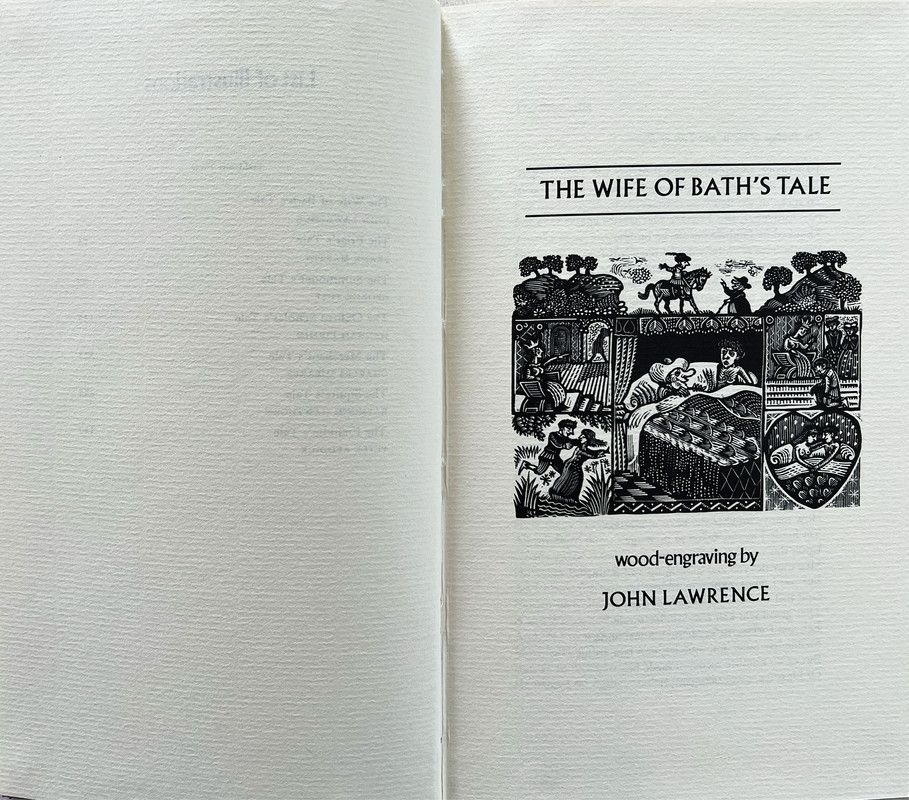
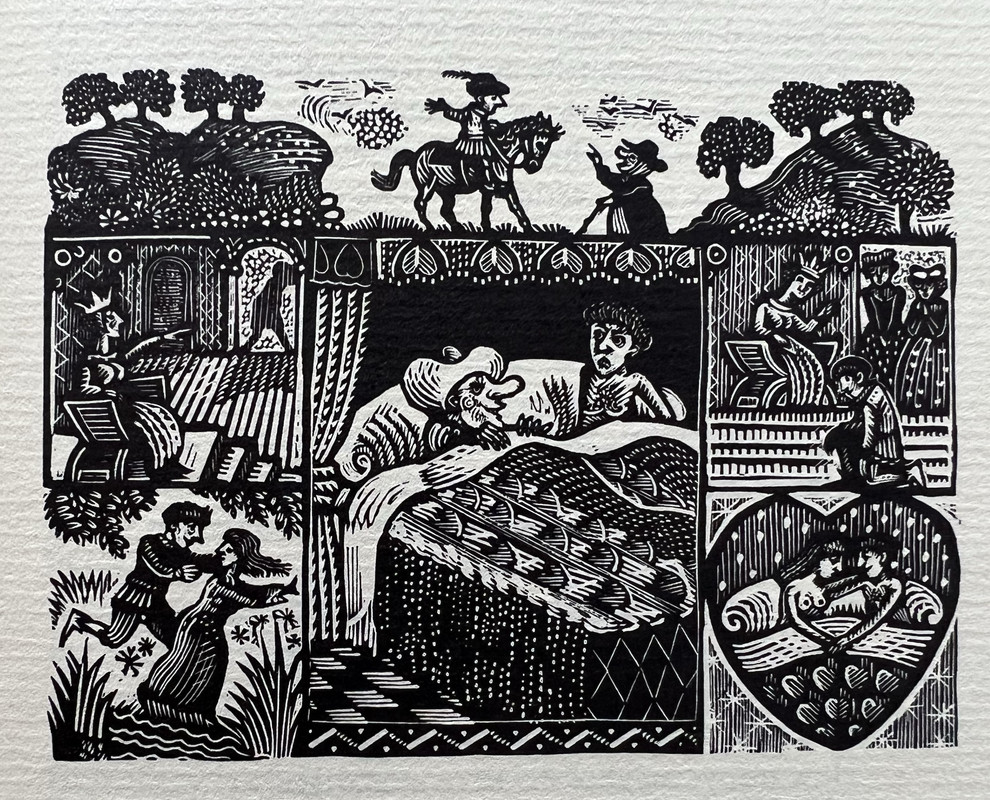
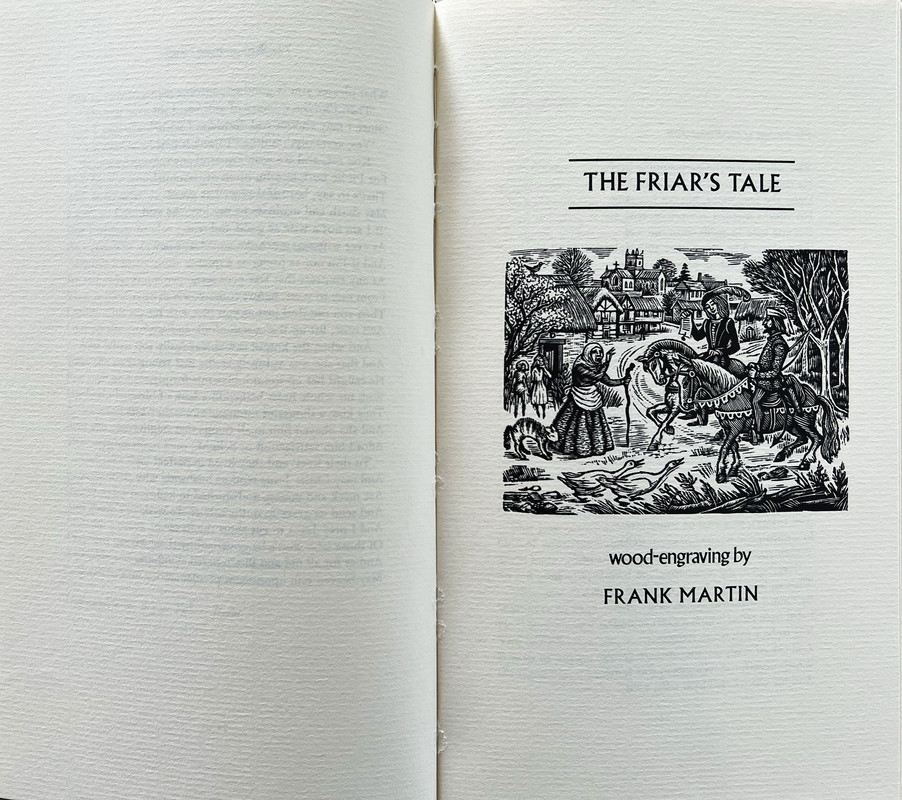
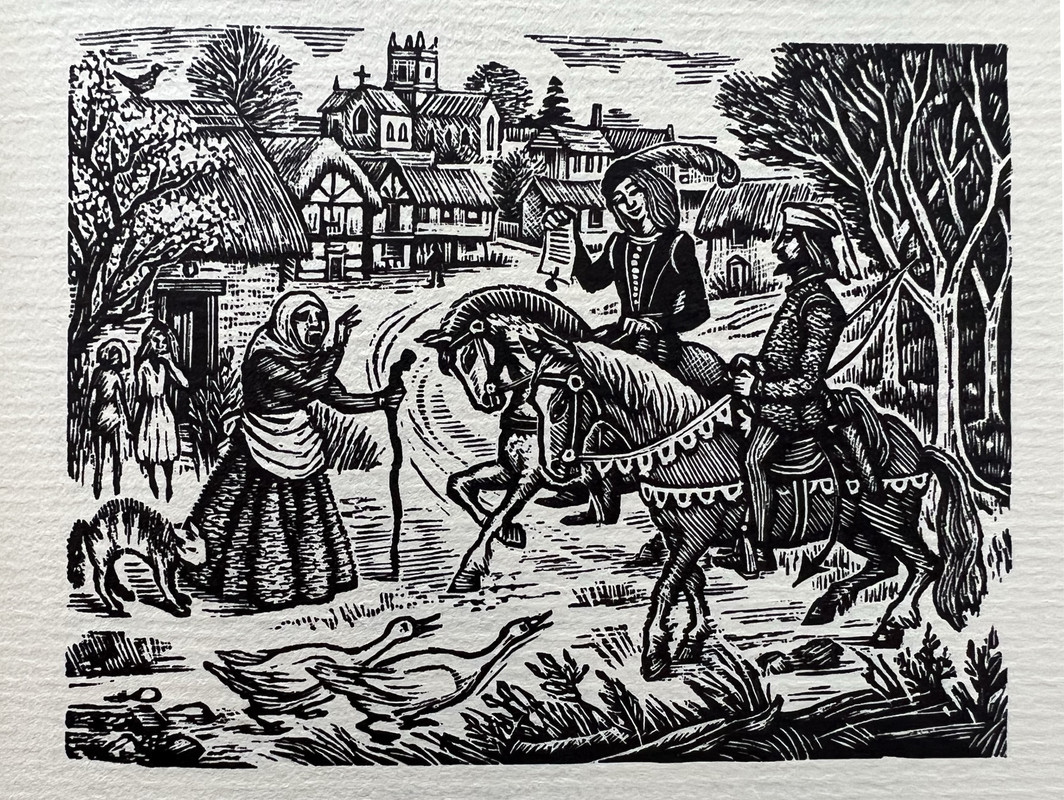
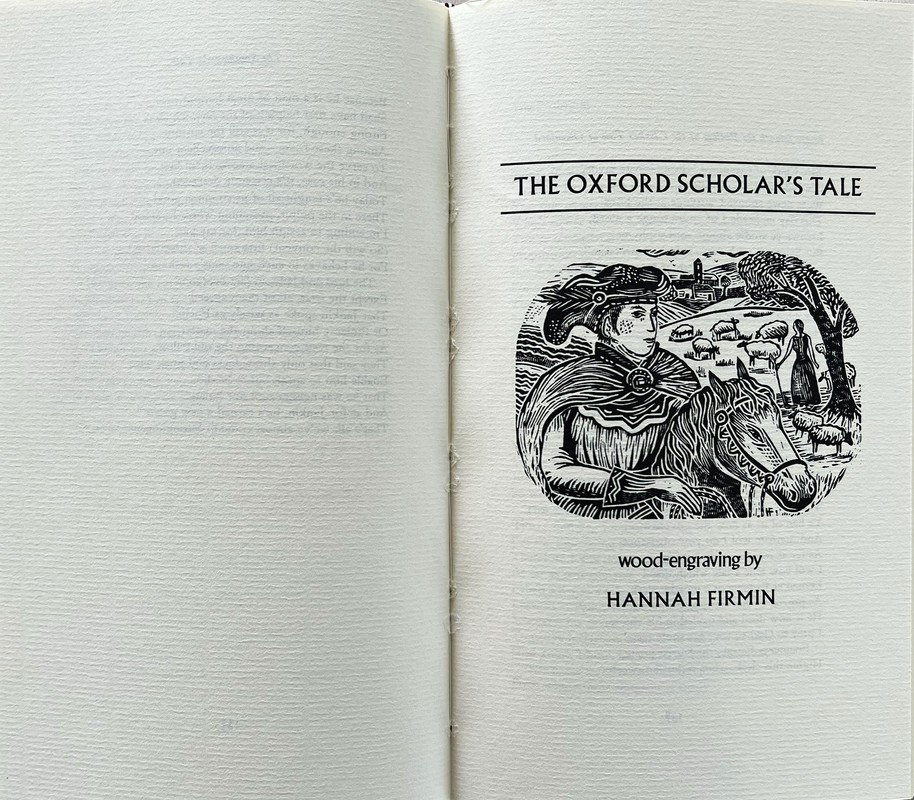
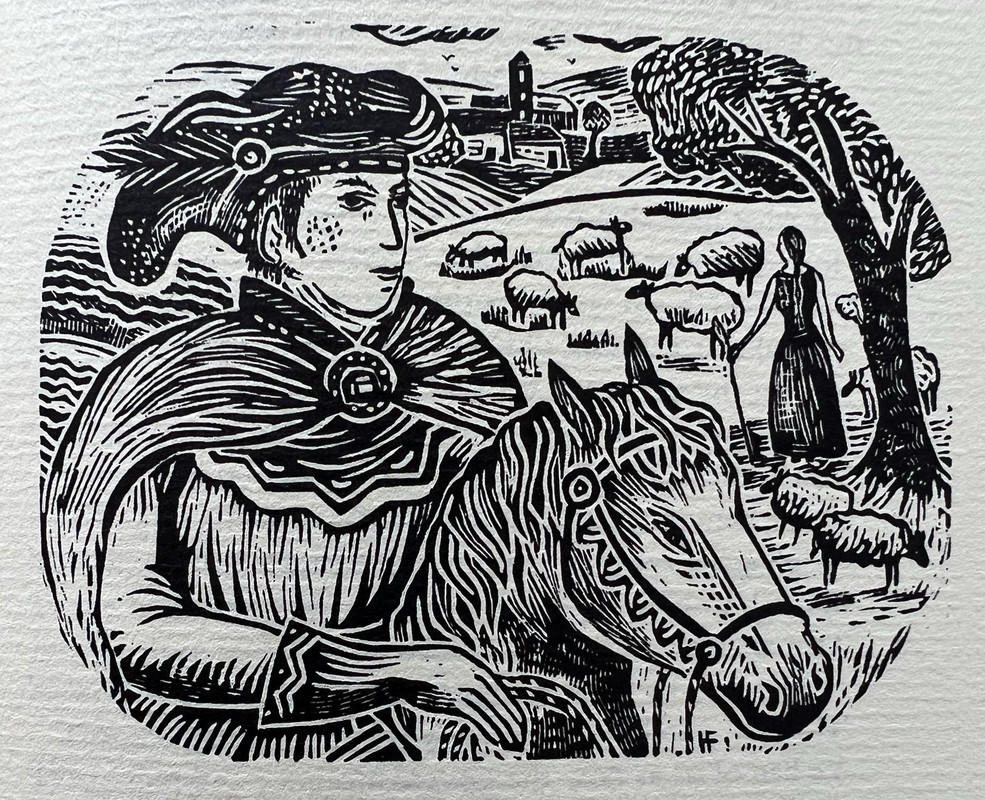

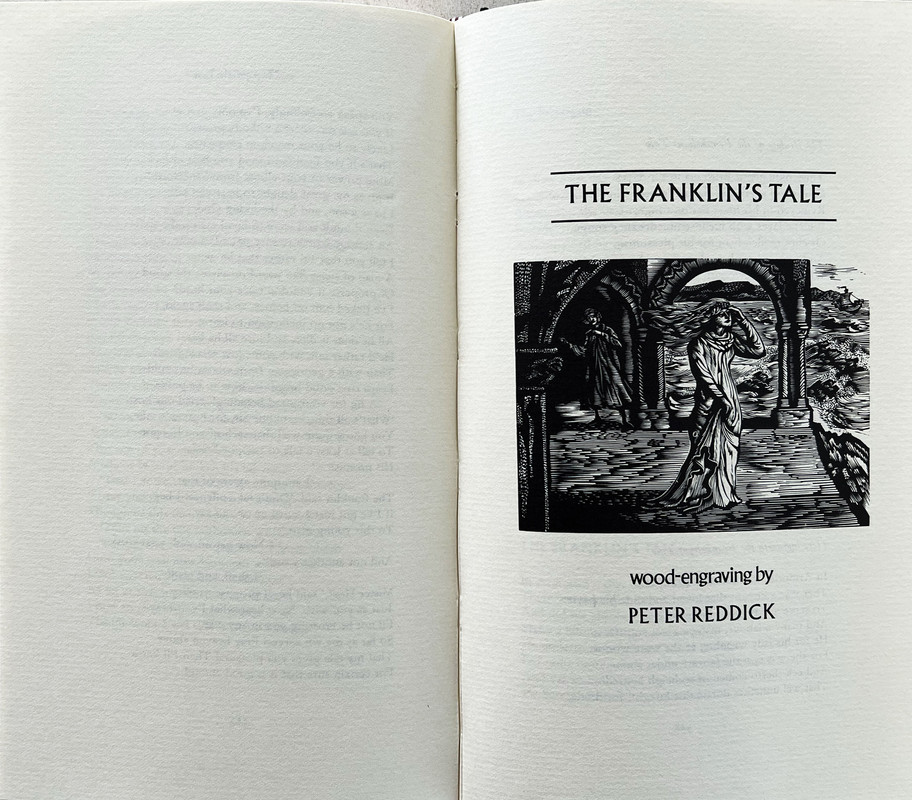
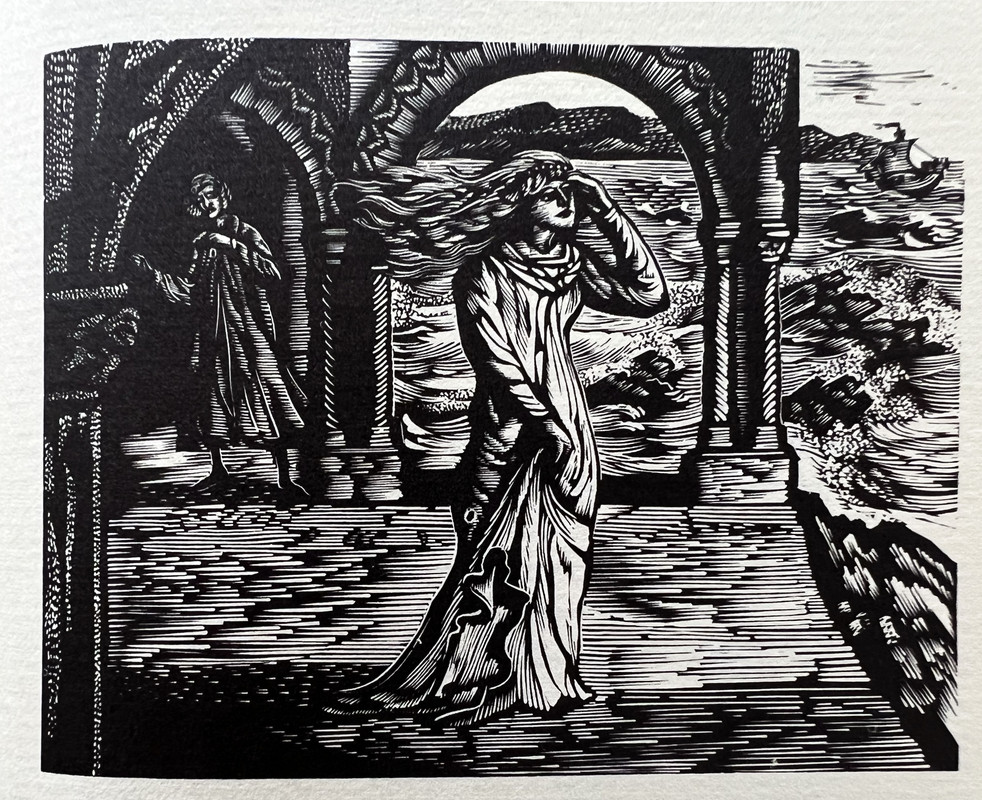
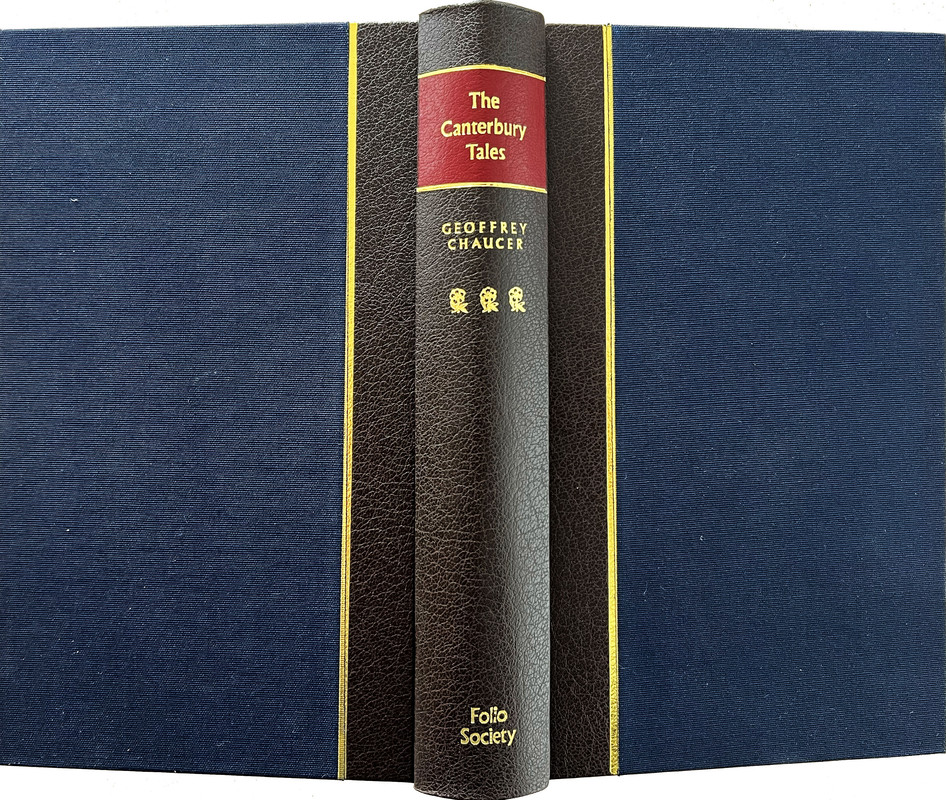
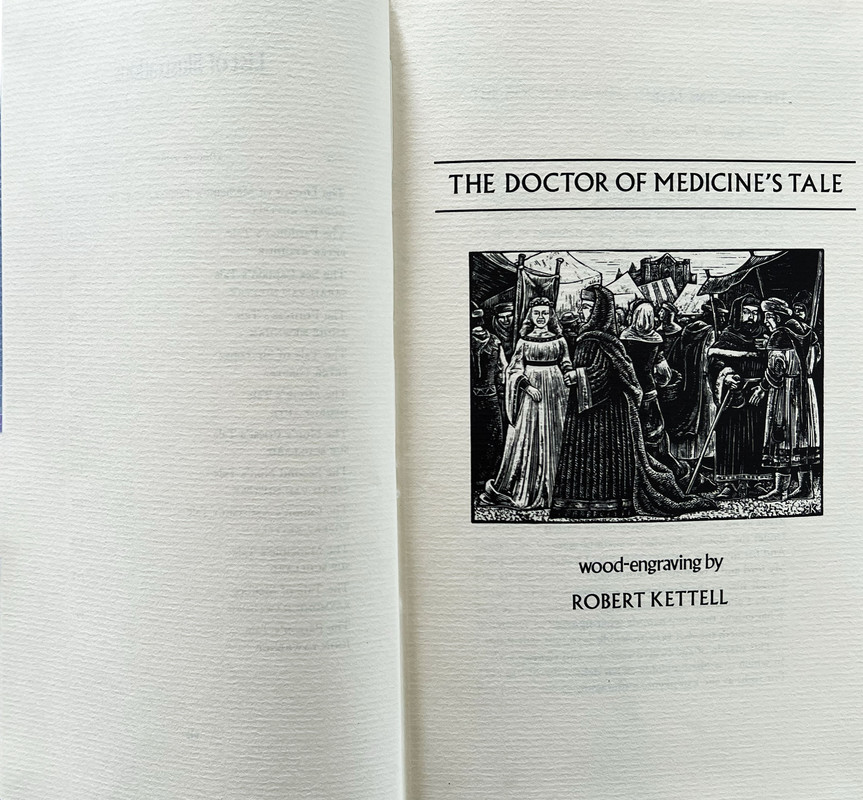
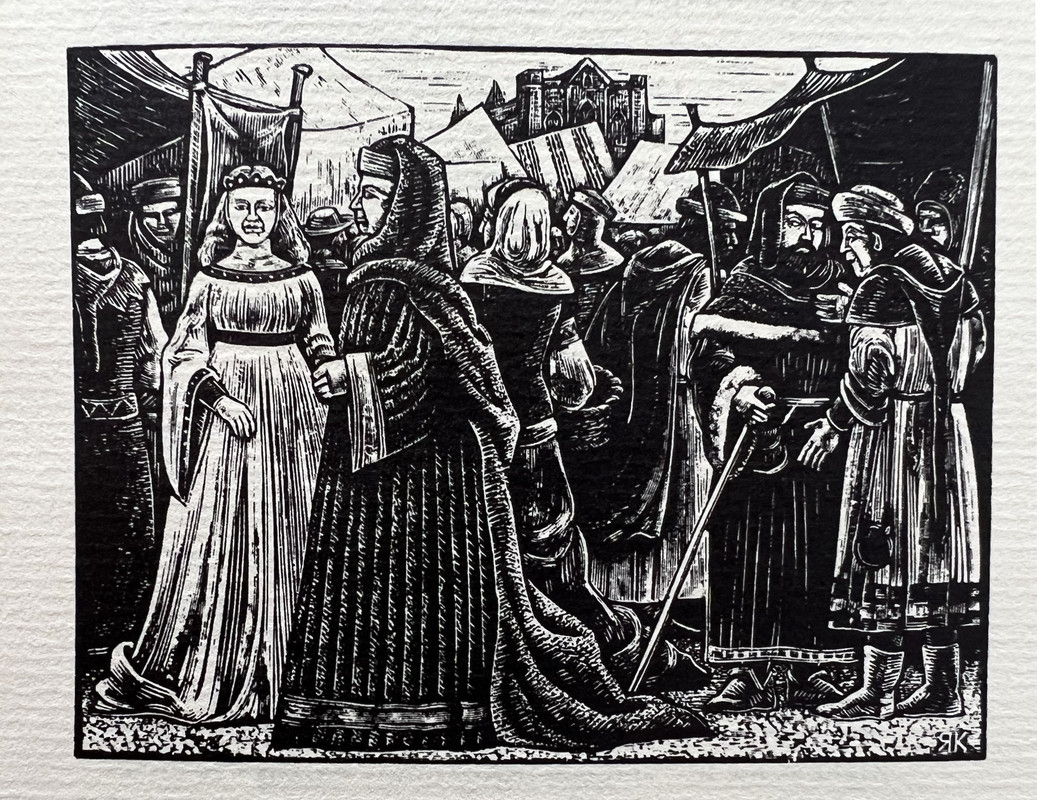
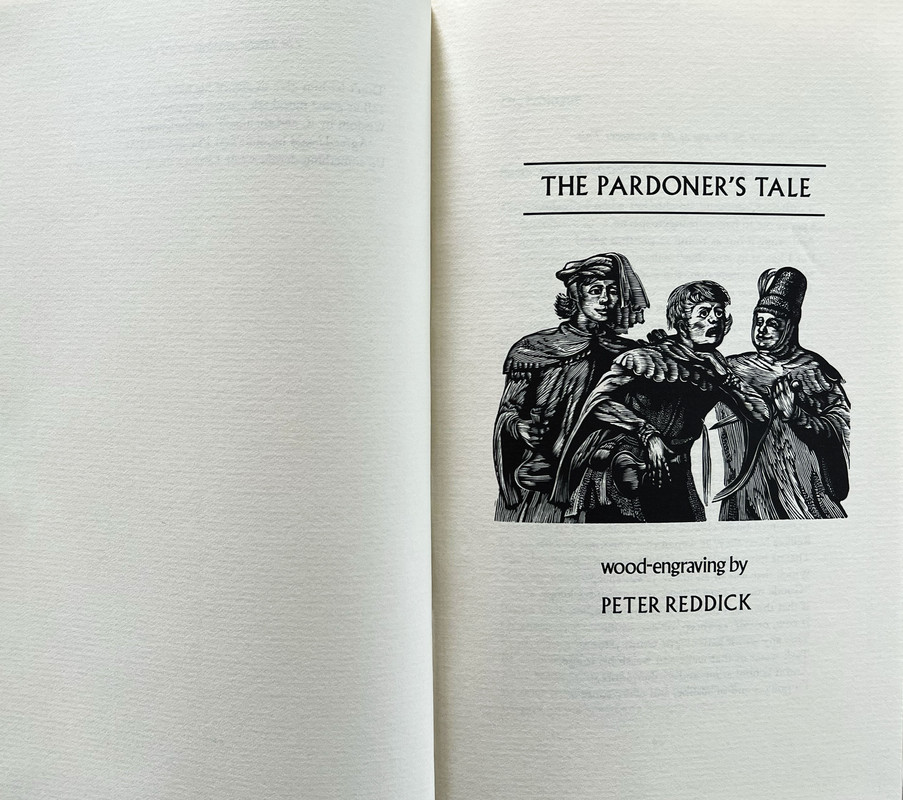

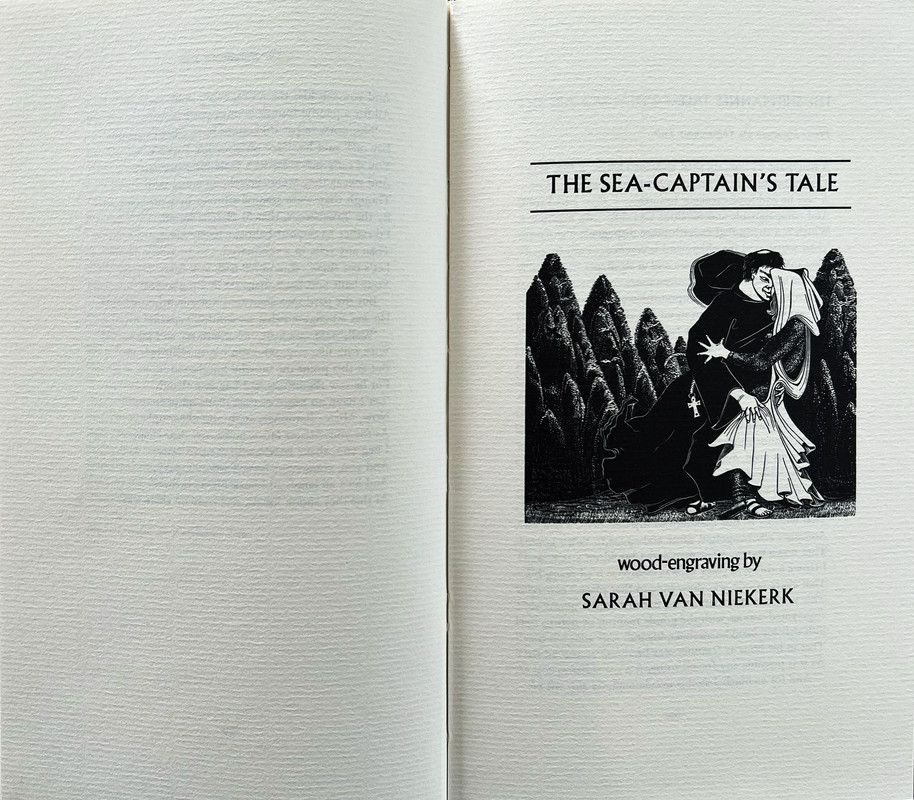


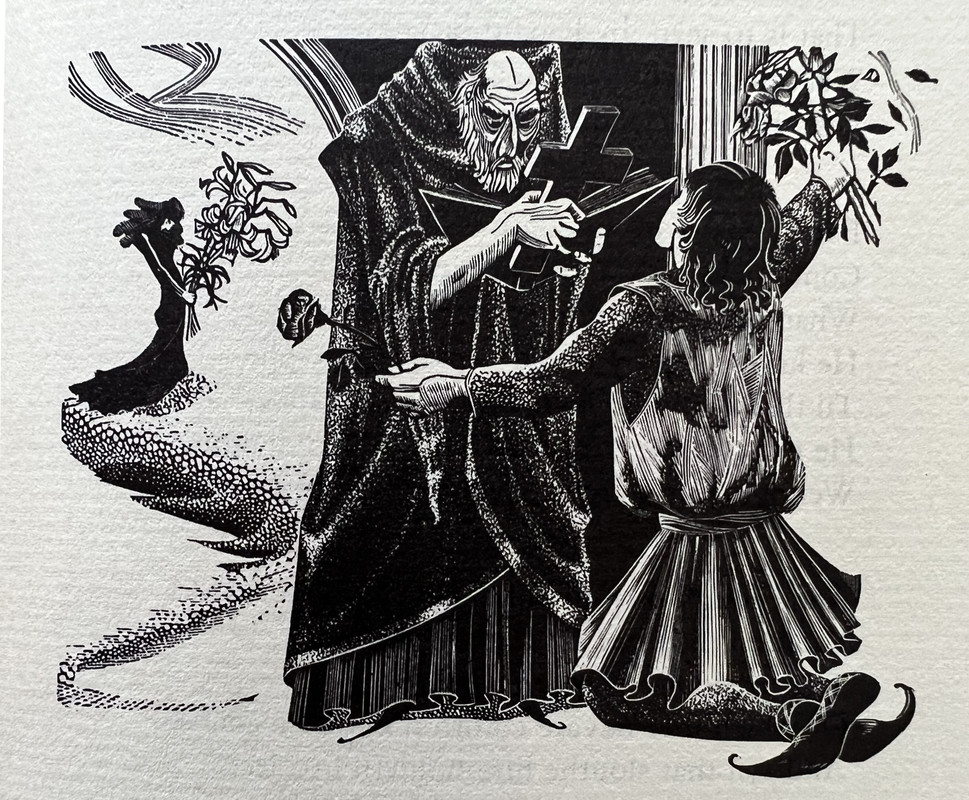
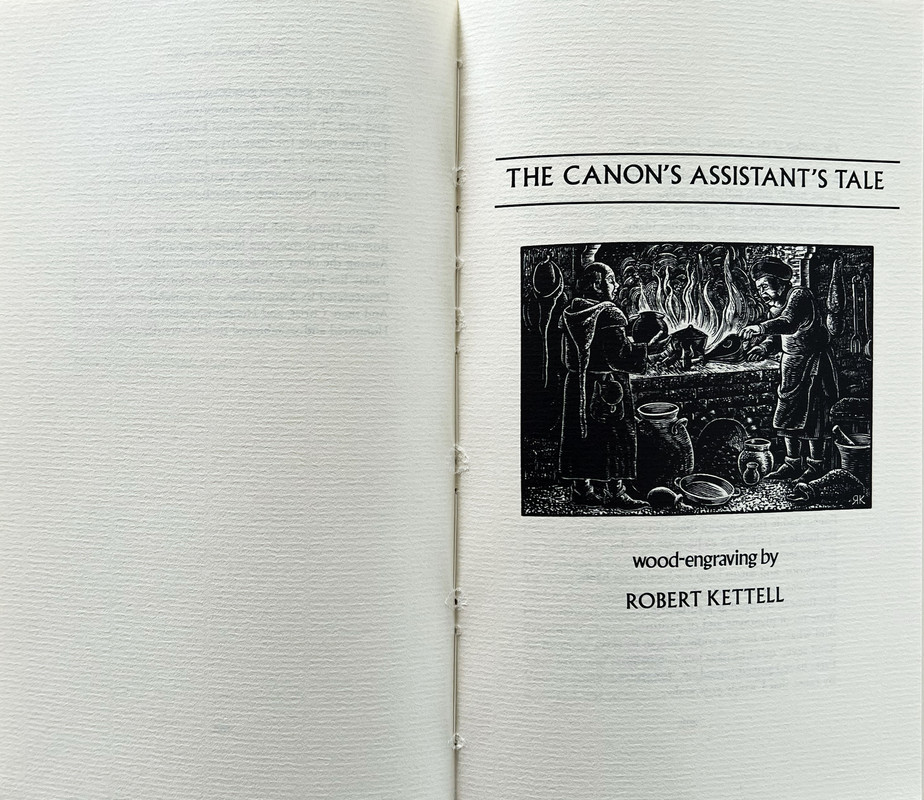


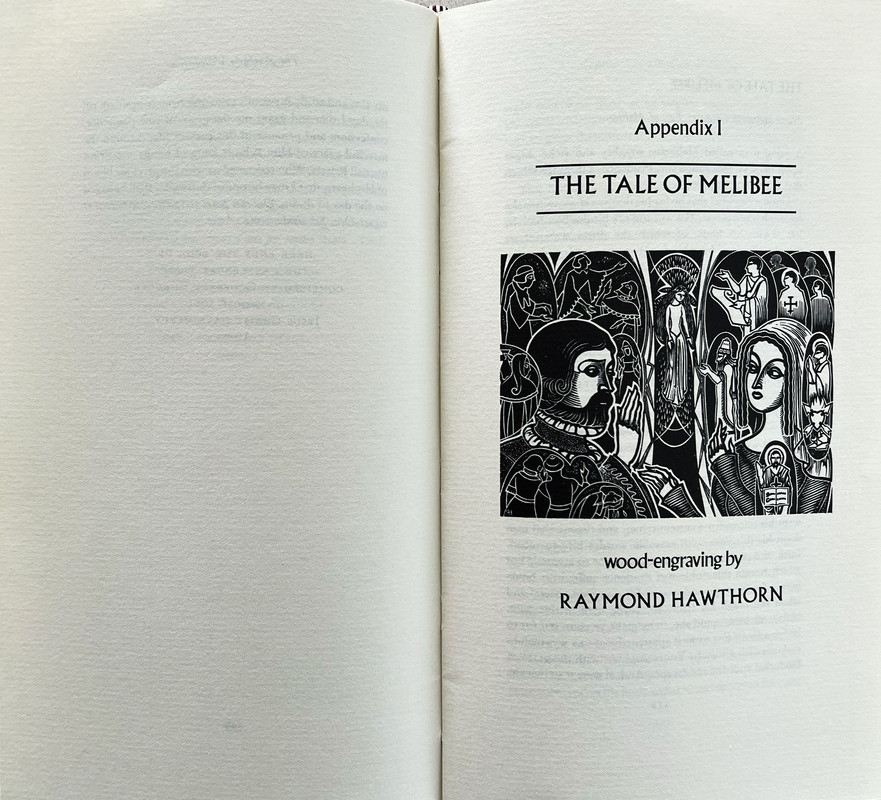
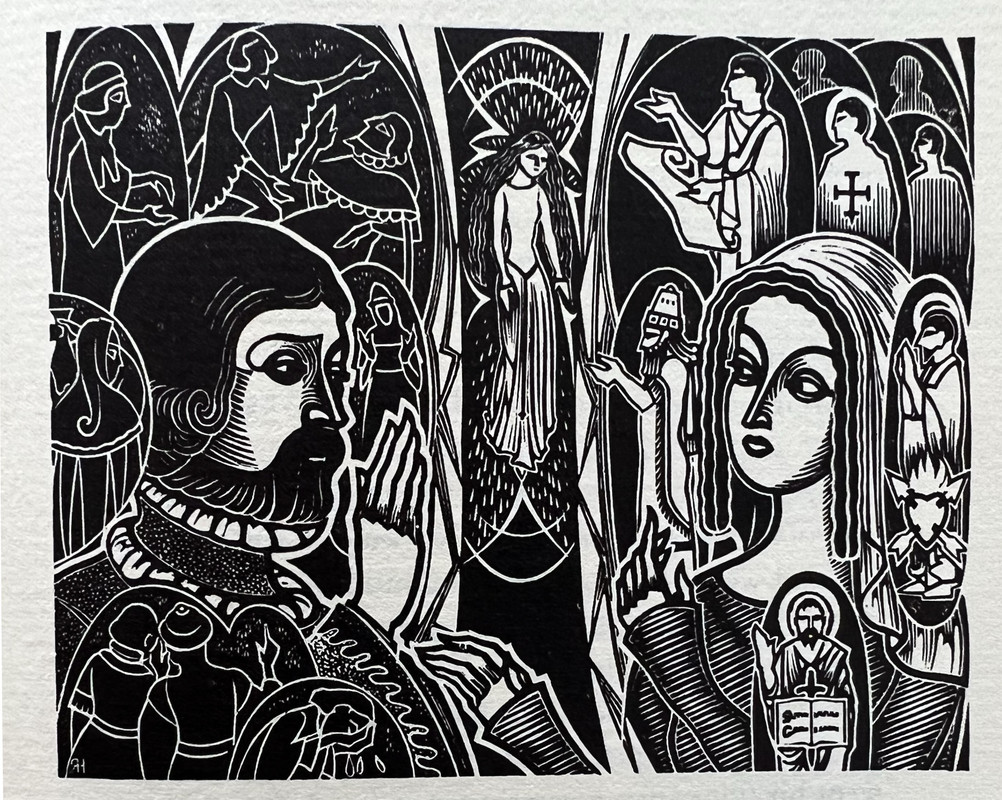
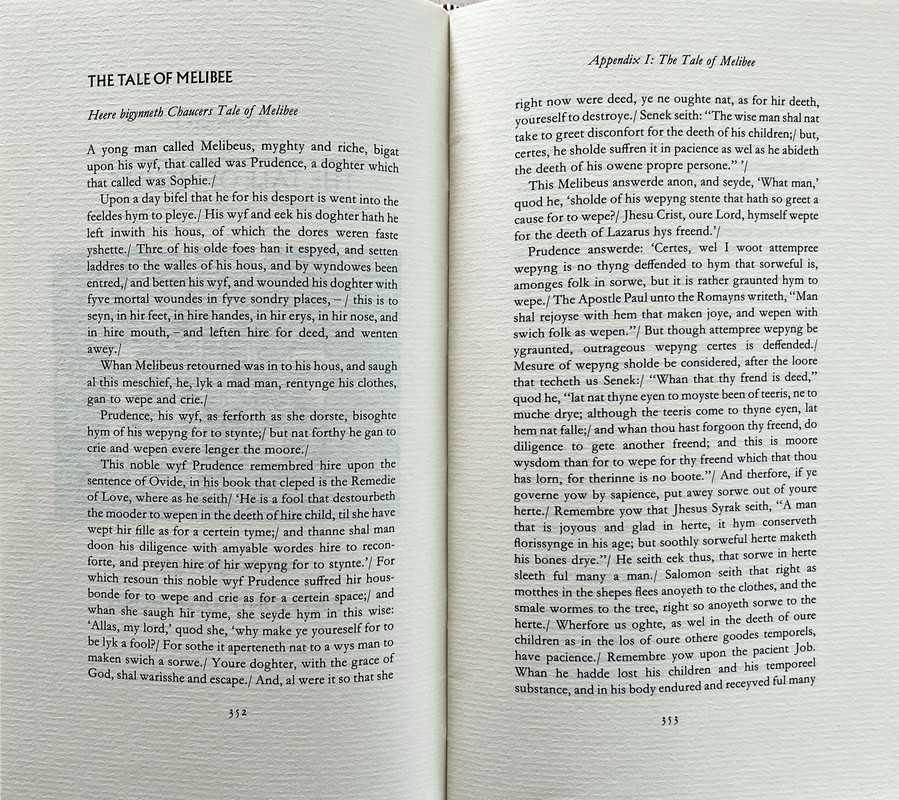



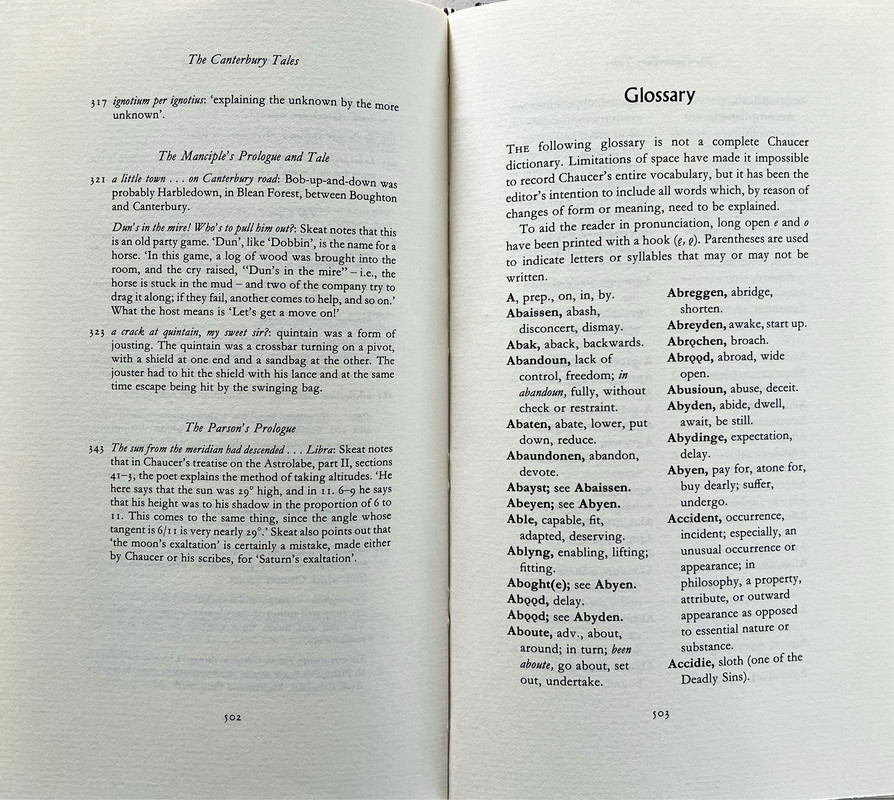
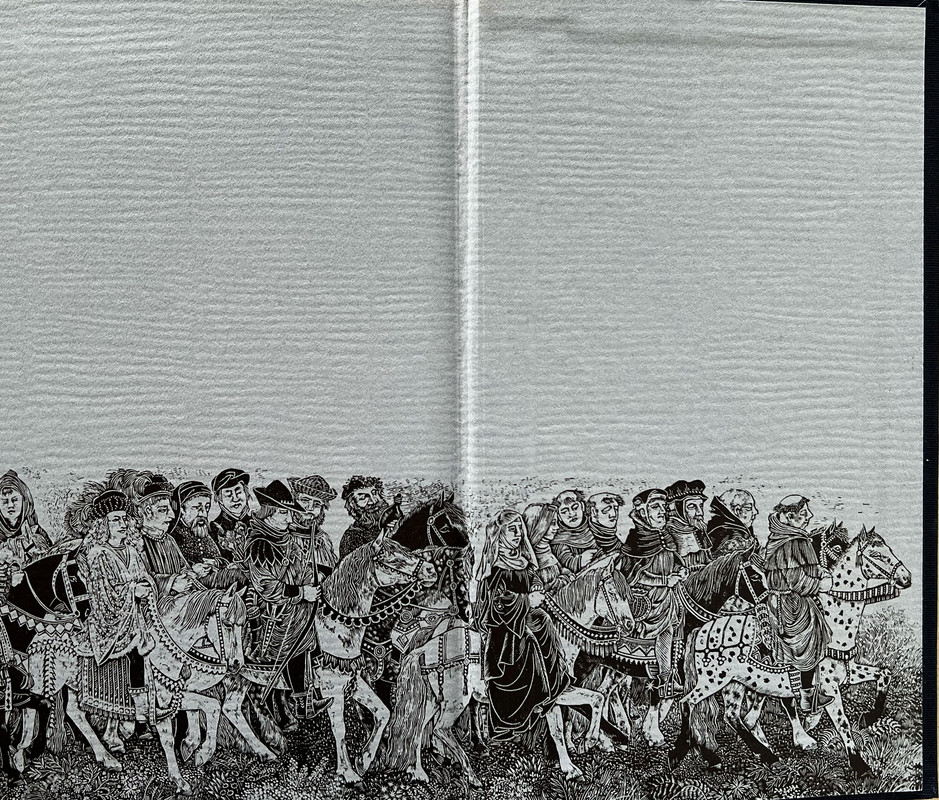
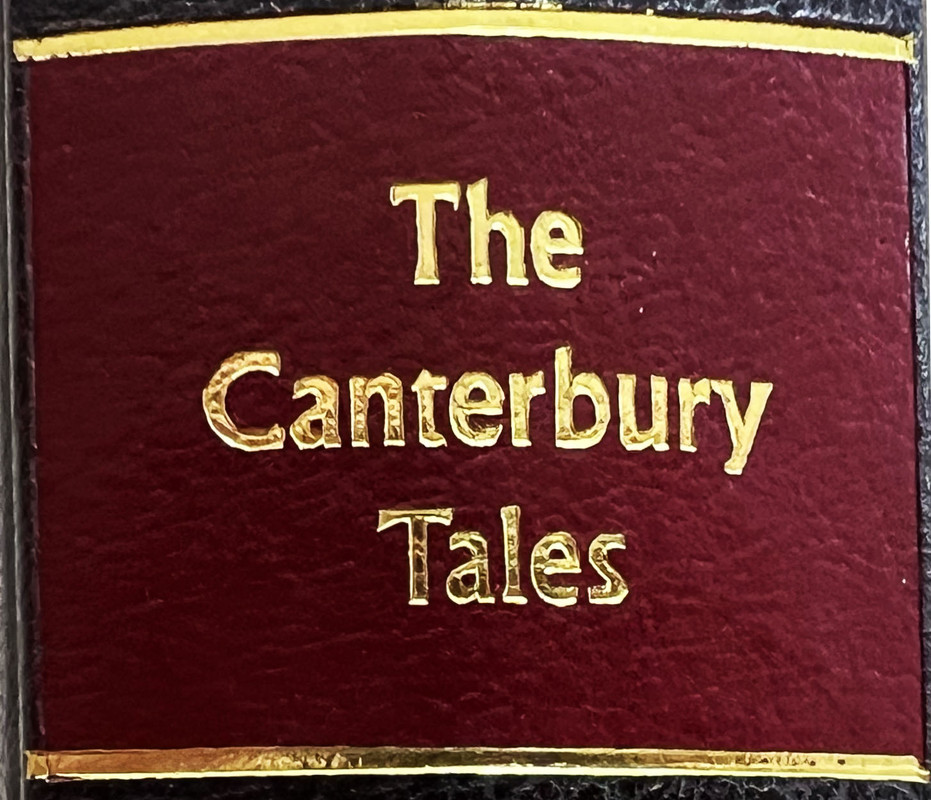
An index of the other illustrated reviews in the "Folio Archives" series can be viewed here.
The Canterbury Tales were written in Old English towards the end of Chaucer’s life between 1390 and his death in 1400. They were left uncompleted. Chaucer was a wealthy man, well travelled, a diplomat and moved in court circles.
The tales themselves are often gruesome (a seven year old boy has his throat cut, a 14 year old girl is beheaded by her father to protect her honour) and bawdy (monks seem to fornicate in many stories), thus making them popular through the ages.
They are difficult to read in the Old English of over 600 years ago, but the edition reviewed here has the original Old English and a modern English translation side by side on opposite pages, making it perfect for both scholar and contemporary reader. The translation is in verse, rather than prose, in an attempt to match the original style as closely as possible. There are introductions by both the translator (David Wright) and editor (E.N.Robinson). Interestingly, the two appendices (the Tale of Melibee and The Parson’s Tale) are not translated.
The 1990 edition reviewed below is in three volumes, but except for its binding is identical to the 1986 edition, and there is no mention in the book that this is actually a new binding from 1990. I find this to be the most pleasing of the many standard editions in both contents and binding. The fine and limited editions are all beautiful, but in Old English.
Each volume is quarter bound in dark brown leather with different colour cloth boards for each volume. The red slipcase is 4.9x15.3cm. The title page and contents of the entire set are repeated at the beginning of each volume.
Volume one : 5 engravings, 332 pages, green boards.
Volume two : 7 engravings, 384 pages, red boards.
Volume three : 12 engravings, 600 pages, dark blue boards.
There are engravings by a multitude of different artists at the beginning of each tale. At the end of the third volume is an extensive glossary and reference to notes throughout the text. The endpapers are an image printed black on grey paper that runs on from the front to the back and is the same in each volume.
The Folio Society has printed the Canterbury Tales numerous times as a standard edition, fine edition and limited edition.
1956
Canterbury Tales, Volume I. Translated by Nevill Coghill. 12 full page and 20 smaller woodcuts by Edna Whyte. Quarter bound in dark brown leather with grey-brown canvas boards. White dust-jacket printed in dark green and black. Design printed endleaves. 287pp. 22x13cm.

1957
Canterbury Tales, Volume II. Translated by Nevill Coghill. Ten full-page and 22 smaller woodcuts by Edna Whyte. Quarter bound in dark brown leather, grey-brown canvas boards. Endleaves with a design in black by Whyte. White dust-jacket printed in dark green and black. 22x12.9cm. 304pp.

1966
Canterbury Tales 2nd. edition, reset. (2v.). Translated into modern English by Nevill Coghill. 22 full page and 42 small woodcut illustrations. Decorated endpapers. Quarter-bound in dark brown leather with canvas boards. Grey-green slipcase. Vol.1 287pp. Vol.2 304pp. Each 22.2x12.5cm.

1974
Canterbury Tales 2nd. edition, as 1966 edition but bound in one volume. Yellow endleaves printed with a brown pattern. Pale brown slipcase. 587pp.

1986
Canterbury Tales. New edition. (3v.). Original text edited by F.N. Robinson. Translation by David Wright. Various illustrators. Quarter bound in red leather, blue cloth boards with a large fleuron in gold. Pale blue endleaves printed in black. Blue slipcase. 23.9x14.3cm. 332/384/600pp.

1990
The edition reviewed below.
1998
Canterbury Tales. Second edition. Single volume version of 1986 edition. Translation, introduction and notes by David Wright. 23 wood engravings by Simon Brett, Peter Forster, John Lawrence, Frank Martin, Peter Reddick, Sue Scullard, George Tute and Sarah van Niekerk. Quarter-bound in red linen with vegetable parchment boards with a gilt design. Red slipcase. 519pp. 24x14.3cm.

2002
Kelmscott Chaucer. Facsimile of 1896 edition by Kelmscott Press. Contains Canterbury Tales and other works by Chaucer. Gilded top edge. Ribbon marker. Bound in white leather blocked in gold with a design by William Morris. Slipcase blocked in gold with title. 568pp. 43.5x31.5cm. Limited edition of 1000 copies.

2008
Kelmscott Chaucer. Facsimile of 1896 edition by Kelmscott Press. Contains Canterbury Tales and other works by Chaucer. Gilded top edge. Ribbon marker. Bound in maroon buckram blocked in gold with a design by William Morris. Brown slipcase blocked in gold with title. 568pp. 43.5x31.5cm. Fine edition.
This edition reviewed here.

2010
Canterbury Tales (2v.). Facsimile printed on felt-marked laid paper, endpapers of Merida Graphite, bound in Nigerian goatskin leather blocked with a 24-carat gold design, gilding on all three book edges, black satin ribbon marker, 768pp. Commentary essay by Peter Holliday quarter-bound in buckram. Buckram-bound solander box with gold blocking on the spine. 12½x7¾in. Limited edition of 1980 copies.

The Canterbury Tales by Geoffrey Chaucer in three volumes - 1990




















































An index of the other illustrated reviews in the "Folio Archives" series can be viewed here.
2dlphcoracl
Random comments:
1. The translations by Neville Coghill and David Wright are both outstanding - take your pick.
2. The single volume 1998 edition with red cloth & vegetable parchment over board is sinfully ugly. Avoid at all costs.
3. The 3-volume bilingual set with David Wright's translation (1986 and 1990) is one of the Folio Society joys. It is beautifully designed and executed and for those that must have the original version in Ye Olde Englische, the arrangement of Old English on verso page with Wright's modern English translation directly across on the recto page is both effective and pleasing.
4. For those who want a facsimile of the Kelmscott Chaucer, nothing compares to the magnificent edition from the Basilisk Press (1974/1975), limited edition of 515 copies. This pops up as auction 1 or 2 times per year and can be purchased at prices well below what booksellers are asking. If purchased at auction, the Basilisk Press facsimile will give you 90% of the aesthetic pleasure of the original Kelmscott Press edition at 2-3% of its price.
1. The translations by Neville Coghill and David Wright are both outstanding - take your pick.
2. The single volume 1998 edition with red cloth & vegetable parchment over board is sinfully ugly. Avoid at all costs.
3. The 3-volume bilingual set with David Wright's translation (1986 and 1990) is one of the Folio Society joys. It is beautifully designed and executed and for those that must have the original version in Ye Olde Englische, the arrangement of Old English on verso page with Wright's modern English translation directly across on the recto page is both effective and pleasing.
4. For those who want a facsimile of the Kelmscott Chaucer, nothing compares to the magnificent edition from the Basilisk Press (1974/1975), limited edition of 515 copies. This pops up as auction 1 or 2 times per year and can be purchased at prices well below what booksellers are asking. If purchased at auction, the Basilisk Press facsimile will give you 90% of the aesthetic pleasure of the original Kelmscott Press edition at 2-3% of its price.
3wongie
Having bought copies of 1956/57 two volume set I've become enamoured by their dimensions; there are a number of other Folio volumes of the same height and width of the spine but these two Canterbury books specifically are slightly shorter along their front boards and this makes them feel amazingly snug whilst holding them in my hands. Out of all my Folios these two are the only ones I'd say are perfectly proportioned.
4Willoyd
This is one of my all-time favourite Folio productions - amongst my favourites of any book. I had copies of the Folio Kelmscott (non-LE) and the Eric Gill LE, but sold them off a while ago whilst thinning my collection down, keeping this one. It's perfect for reading (the others were fine for the odd browse, but they were products not books to be read), and I love the woodcuts. This is exactly what sold FS to me (and the lack of which being why I so rarely buy anything new today).
5rbee
The Canterbury Tales are Middle English not Old English. This is not a pedantic difference. Old English is Anglo Saxon, which is the language Beowulf was written in. Old English is roughly as difficult to learn as German. Middle English can be understood by modern English readers with some effort. There were a number of dialects of Middle English. So Sir Gawain and the Green Knight and Piers the Plowman were written in different dialects of Middle English than the Canterbury Tales. Chaucer is the strain of Middle English that modern English to a large extent developed from, so it's easier to read than some of the other Middle English texts.
I'm not trying to be overly critical. Thanks for the fabulous pictures and the informative posts. I have read through most of them and have discovered many books. I find your posts enlightening as I irresponsibly splurge my income on books.
I'm not trying to be overly critical. Thanks for the fabulous pictures and the informative posts. I have read through most of them and have discovered many books. I find your posts enlightening as I irresponsibly splurge my income on books.
6bacchus.
>5 rbee: Thanks for the info on language (if there was a “like” button I’d use that instead)
7rbee
>6 bacchus.: Thanks
8kermaier
>1 wcarter: Your copy appears to be printed on very nice paper (Edinburgh cream laid, from the colophon). Later printings of the same 1990 edition may be on different paper. The 4th printing, for example, is on Folio Special Parchment, which appears to be a smoother, wove surface.
9Powderfinger69
>1 wcarter: Thank you enabling me with another fine review. My copy of the 1990 on Edinburgh cream laid paper just arrived. I am definitely keeping the Gill facsimile, but this will be my regular reading copy.
10BorisG
Adding my thanks to >1 wcarter: for the enablement! Was able to find a very-reasonably-priced fine copy of the 1986 edition on Edinburgh cream laid paper, and it’s a delight. Can’t help but think that a similar production from the FS today would cost 3-4 times as much…
Edit: typo
Edit: typo

